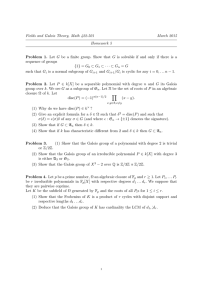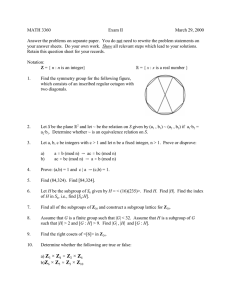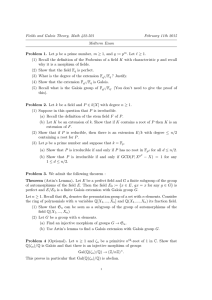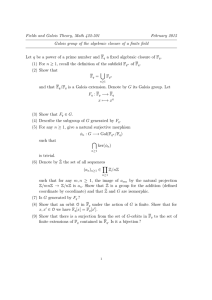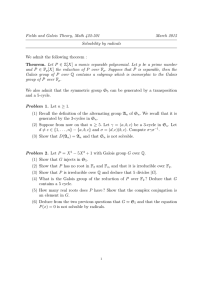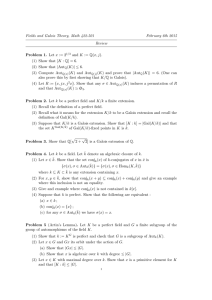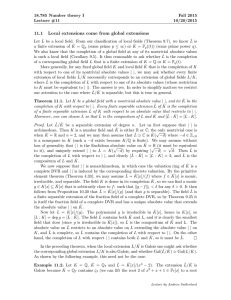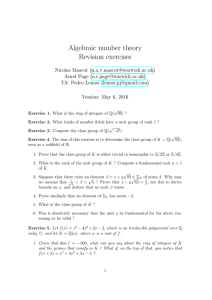Fields and Galois Theory, Math 422-501 March 18th 2015 Midterm Exam
advertisement
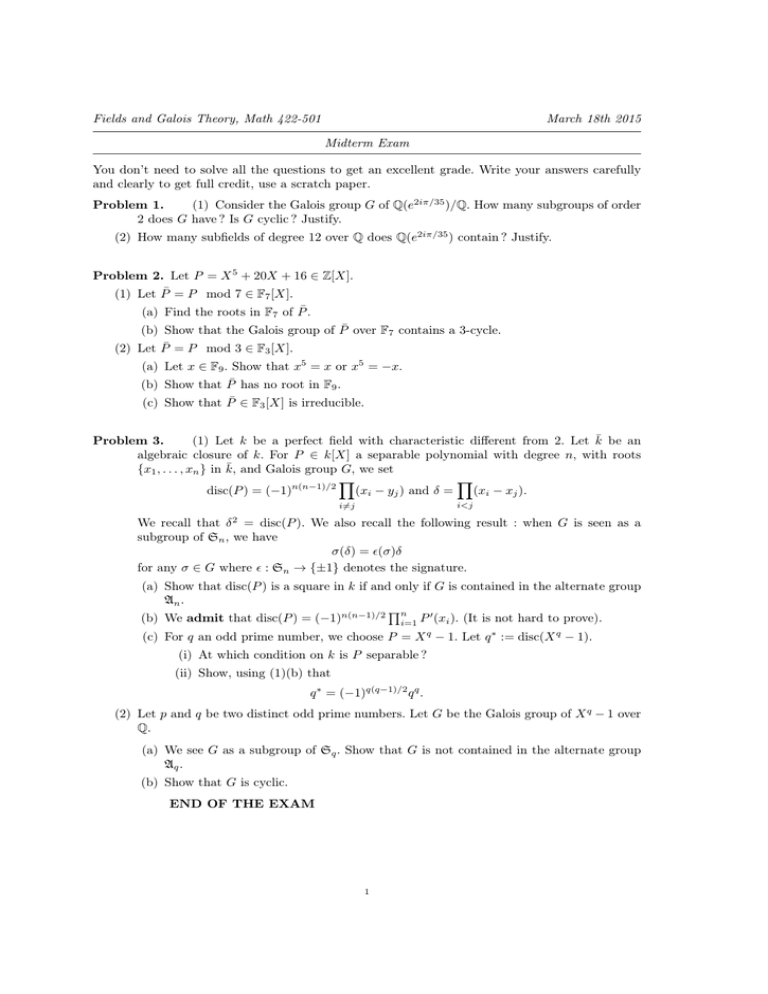
Fields and Galois Theory, Math 422-501
March 18th 2015
Midterm Exam
You don’t need to solve all the questions to get an excellent grade. Write your answers carefully
and clearly to get full credit, use a scratch paper.
Problem 1.
(1) Consider the Galois group G of Q(e2iπ/35 )/Q. How many subgroups of order
2 does G have ? Is G cyclic ? Justify.
(2) How many subfields of degree 12 over Q does Q(e2iπ/35 ) contain ? Justify.
Problem 2. Let P = X 5 + 20X + 16 ∈ Z[X].
(1) Let P̄ = P mod 7 ∈ F7 [X].
(a) Find the roots in F7 of P̄ .
(b) Show that the Galois group of P̄ over F7 contains a 3-cycle.
(2) Let P̄ = P mod 3 ∈ F3 [X].
(a) Let x ∈ F9 . Show that x5 = x or x5 = −x.
(b) Show that P̄ has no root in F9 .
(c) Show that P̄ ∈ F3 [X] is irreducible.
Problem 3.
(1) Let k be a perfect field with characteristic different from 2. Let k̄ be an
algebraic closure of k. For P ∈ k[X] a separable polynomial with degree n, with roots
{x1 , . . . , xn } in k̄, and Galois group G, we set
Y
Y
disc(P ) = (−1)n(n−1)/2 (xi − yj ) and δ =
(xi − xj ).
i<j
i6=j
2
We recall that δ = disc(P ). We also recall the following result : when G is seen as a
subgroup of Sn , we have
σ(δ) = (σ)δ
for any σ ∈ G where : Sn → {±1} denotes the signature.
(a) Show that disc(P ) is a square in k if and only if G is contained in the alternate group
An .
Qn
(b) We admit that disc(P ) = (−1)n(n−1)/2 i=1 P 0 (xi ). (It is not hard to prove).
(c) For q an odd prime number, we choose P = X q − 1. Let q ∗ := disc(X q − 1).
(i) At which condition on k is P separable ?
(ii) Show, using (1)(b) that
q ∗ = (−1)q(q−1)/2 q q .
(2) Let p and q be two distinct odd prime numbers. Let G be the Galois group of X q − 1 over
Q.
(a) We see G as a subgroup of Sq . Show that G is not contained in the alternate group
Aq .
(b) Show that G is cyclic.
END OF THE EXAM
1
2
The following questions are not to be solved for the exam.
We identify G with the group (Z/qZ)∗ . We denote by 1 the unit element in G. Since
q is odd, we have −1 6≡ 1 mod q and we denote the element −1 mod q of G simply
by −1.
(c) Show that the map
Ψ : G −→ {±1}
g 7−→ g (q−1)/2
is a well defined surjective morphism of groups. For g ∈ G we use the following
notation :
g
:= Ψ(g)
q
.
(d) Show that the kernel H of Ψ is the unique subgroup of G of index 2 (that is to say
such that |G| = 2|H|).
(e) Show that H is the image of the morphism of groups G → G, g 7→ g 2 .
(f) What is the kernel of
G ,→ Sq −→ {±1}?
(g) Show that for any g ∈ G seen as an element of Sq we have (g) =
g
.
q
(h) Let ζ := e2iπ/q . Show that there is a unique f ∈ G such that f (ζ) = ζ p .
(i) Why can p be seen as an element of G ? Check that
p
= 1 if and only if p is a square mod q.
q
p
.
q
(k) Let A = Z[ζ]. We recall that there is P a maximal ideal of A such that P ∩ Z = pZ.
(j) Show that f ∈ H if and only if p is a square mod q. Show that (f ) =
(i) Recall why K := A/P is a finite field of characteristic p.
(ii) We know that the decomposition subgroup D := {g ∈ G, g(P) = P} of G is
isomorphic to Gal(K/Fp ). Show that in this isomorphism, the element f ∈ G
corresponds to the Frobenius of K/Fp (show first that f ∈ D).
(iii) Why is there an embedding of Gal(K/Fp ) in Sq which is compatible with the
embedding of G in Sq via the isomorphism of the previous question ?
Show that the Frobenius of K/Fp is in Aq if and only if q ∗ is a square modulo
p if and only if ((−1)(q−1)/2 q)(p−1)/2 = 1.
(iv) Prove the quadratic reciprocity law :
q
p
= (−1)(p−1)(q−1)/4 .
q
p
(3) Prove the result of Question (1)(b).

